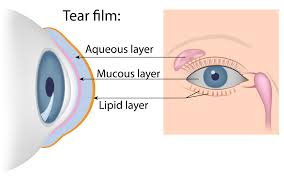Dry Eye at OMEG
At Oklahoma Medical Eye Group you will find answers for a condition that so many Oklahomans suffer from: dry eye. Many people do not realize that dry eye is a progressive and complex condition. It can interrupt the health of your eyes and degrade your vision. Dry eye warrants a complete work up and individualized treatment plan.

What is Dry Eye?
Dry eye is a progressive inflammatory condition caused by a problem in the tear film. This tear film is an important layer that coats the outer portion of the eye and contributes to vision clarity and comfort.
The tear film has three main components: a lipid (oil) layer, an aqueous (water) layer, and a mucin layer. Deficiencies in any one of these layers can worsen dry eye disease.

Two Main Types of Dry Eye
Aqueous deficient dry eye
There are numerous reasons our lacrimal glands just do not make enough of the ‘water’ or aqueous part of the tears. Systemic conditions, medications, autoimmune disease, age, etc can all contribute to the disease. Having enough healthy tears is what maintains a clear healthy surface of the cornea. Remember, this is the first surface that light encounters as it enters the eye – so a disrupted surface will cause vision problems and fluctuations, along with irritation, redness, and discomfort.
Evaporative dry eye
Evaporative dry eye is caused by inflamed or clogged meibomian glands. On our eyelids, there are large oil glands that create the oil layer of the tear film. That oil layer is responsible for keeping our tears on the surface of the eye. Without it, the tears evaporate too quickly. Dysfunction of the glands indicates chronic inflammation of the eyelids. This condition is progressive and can become irreversible if not treated.
It is important to properly diagnose what kind of dry eye you have because they are treated differently. Many times, aqueous deficient and evaporative dry eye can be found in the same patient.
Symptoms of a dry eye
- Dryness, grittiness, or scratchiness
- Soreness or irritation
- Burning or watering
- Eye fatigue
- Blurry vision
Blinking is very important for the maintenance of the tear film. When performing activities such as reading or working on a computer, we blink less frequently, which can increase the symptoms of dry eyes. Environmental factors can also worsen dry eye symptoms including dry weather, wind, cigarette smoke, fumes, and dust.



